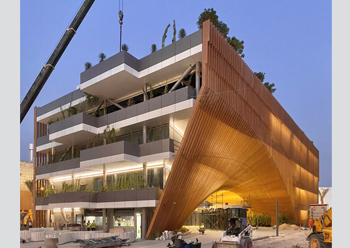
 Belgian Pavilion ... complete.
Belgian Pavilion ... complete.
Leading infrastructure group Besix has announced that it has completed the construction of Belgium’s country pavilion for the Expo 2020 Dubai and handed it over to BelExpo, the Belgian General Commission for International Exhibitions.
Designed jointly by Besix Group and the Belgian architects Vincent Callebaut and Assar, this building will showcase Belgium, its talents and its assets.
The Belgian Pavilion is now part of Besix’s portfolio and of Belgian representation at world fairs, says the Belgian infrastructure group. In 2015, the company had built the Belgian Pavilion for the Milan World Expo. After the event, Besix re-assembled it in Belgium, on top of the Citadel of Namur for the city authorities.
The Belgian Pavilion in Dubai too can be dismantled and reassembled in the same way after the event, the company says.
Group Deputy CEO Pierre Sironval says: “Besix is very proud to deliver to Belgium this outstanding building, both in terms of architecture and scenography. It will be one of the most emblematic pavilions of the Dubai World Expo, with its spectacular parabolic arch and its panoramic terrace offering a unique view of the Expo site.
“This link between us and world fairs continues even to this day and we are very proud to accompany Belgium all the way to the UAE where we have been active since 1965.”
For the construction of the building, Besix was able to count on Six Construct, the group’s subsidiary in the Middle East. The collaboration of the teams in Brussels and Dubai was an essential factor in the success of the project, he adds.
Managing Director (Middle East) Olivier Crasson says: “We are very proud to have contributed to making this vision a reality, including building the inspiring and beautiful Belgian and French pavilions.”
Besix Group completed the construction of the French Pavilion for the Expo 2020 Dubai and handed it over to the authorities in April.
Designed by the architectural firms Atelier Perez Prado and Celnikier & Grabli Architects and the design office OTE Ingénierie on the specific theme of “Lumière, Lumières” (“Light, Lights”), the French Pavilion reflects the commitment of the French Republic to play a key role in the global ecological transition.
The French Pavilion exemplifies the principles of bioclimatic architecture, which is reflected in the choice of materials and a focus on the circular economy, considerably limiting the building’s carbon footprint. One of the highlights of the pavilion is its ability to be dismantled and reused.
The building will also be virtually self-sufficient in energy during the six months of the World Expo, combining low energy equipment with renewable energy, produced by the 2,500 sq m of solar panels integrated into its façade.





















_0001.jpg)


.jpg)
















.jpg)








.jpg)



